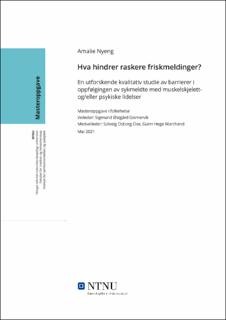| dc.contributor.advisor | Gismervik, Sigmund Østgård | |
| dc.contributor.advisor | Ose, Solveig Osborg | |
| dc.contributor.advisor | Marchand, Gunn Hege | |
| dc.contributor.author | Nyeng, Amalie | |
| dc.date.accessioned | 2021-09-25T16:20:17Z | |
| dc.date.available | 2021-09-25T16:20:17Z | |
| dc.date.issued | 2021 | |
| dc.identifier | no.ntnu:inspera:78875574:11755771 | |
| dc.identifier.uri | https://hdl.handle.net/11250/2782784 | |
| dc.description.abstract | Bakgrunn: Norge har både høy sysselsetting og relativt høyt sykefravær. Det er naturlig at noen arbeidstakere blir langvarig syke, men med store utgifter per langtidssykefravær er det behov for kunnskap om hvordan fraværet kan reduseres. Ved å forstå hva som hindrer arbeidstakere i å returnere ved sykefravær, kommer man et steg nærmere å redusere effekten av barrierene.
Formål: Utforske hva som hindrer aktørene i dagens oppfølgingssystem fra å komme i mål med IA-avtalens ambisjoner om færre sykefraværstilfeller, kortere varighet på sykefraværstilfellene, og mindre frafall fra arbeidslivet. Oppgavens ambisjon er å avdekke barrierer mot friskmelding, og å gi forslag til hvordan barrierene kan reduseres. Overordnet problemstilling er: Hva opplever aktørene i sykefraværsoppfølgingen som barrierer mot friskmelding?
Metode: Oppgavens utforskende forskningsspørsmål besvares ved å innhente og analysere kvalitative data om aktørenes opplevelser og holdninger. Systematisk analyse av datamateriale fra ti fokusgruppeintervju i tilknytning til Dialogmøte 2, tre fokusgruppeintervju med profesjonelle aktører fra oppfølgingsregimet, og to supplerende dybdeintervju med NAV-veiledere.
Resultat: Analysen identifiserer fire overordnede tema som påvirker friskmelding; 1) Rammer i oppfølgingssystemet; 2) Arbeidsplassen; 3) Samhandling og informasjonsdeling; og 4) Ventetid. Innenfor disse temaene trekkes det frem barrierer som vanskeliggjør friskmeldingsarbeid for aktørene i sykefraværsoppfølgingen, og muligheter til å redusere noen av disse barrierene.
Konklusjon: Noen av barrierene kan man være nødt til å leve med også i fremtiden. Hvis man lykkes med å forbedre samhandling, fremme parallelle løp med helse og arbeid, og bygge relasjoner tidlig, bør raskere friskmeldinger likevel være oppnåelig. | |
| dc.description.abstract | Background: Norway has both high employment and relatively high sickness absence. It is natural that some employees become long-term ill, but with large expenses per long-term sick leave, there is a need for knowledge about how the absence can be reduced. By understanding what prevents employees from returning in the event of sick leave, one comes one step closer to reducing the effect of the barriers.
Aim: To explore what prevents the actors in the current follow-up system from achieving the IA agreement's ambitions of fewer cases of sickness absence, shorter duration per case of sickness absence, and less dropouts from working life. The aim of the thesis is to uncover barriers to Return to Work, and to provide suggestions on how the barriers can be reduced. The research question is: What do the actors in the sickness absence follow-up system experience as barriers to Return to Work?
Methods: The thesis' exploratory research question is answered by obtaining and analysing qualitative data about the actors' experiences and attitudes. Systematic analysis of data material from ten focus group interviews in connection with the compulsory dialogue meeting, three focus group interviews with professional actors from the follow-up regime, and two supplementary in-depth interviews with supervisors from the Norwegian Labour and Welfare Administration.
Results: The analysis identifies four main themes that affect Return to Work; 1) The framework of the follow-up system; 2) The workplace; 3) Interaction and information sharing; and 4) Waiting time. Within these topics, barriers that make it difficult for the actors in the follow-up system to ensure Return to Work, are highlighted, along with opportunities to reduce some of these barriers.
Conclusion: Some of these barriers, one may have to live with in the future as well. If one succeeds in improving interaction, promoting parallel processes with health and work, and building relations early, faster Return to Work should still be achievable. | |
| dc.language | nob | |
| dc.publisher | NTNU | |
| dc.title | Hva hindrer raskere friskmeldinger? | |
| dc.type | Master thesis | |
